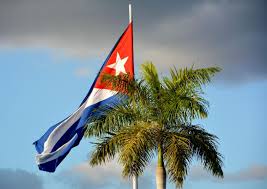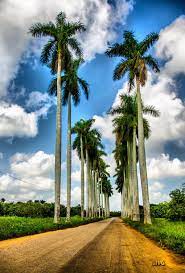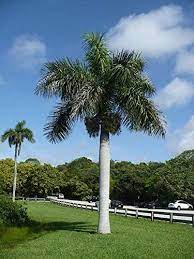LA PALMA REAL CUBANA “LA REINA DE LOS CAMPOS DE CUBA”. PHOTOS.
Árbol emblemático de Cuba. La palma real fue elegida como el árbol nacional en Cuba por ser el más numeroso de sus árboles, por ser la especie más notoria de sus paisajes, por su belleza, por su utilidad y por estar representada en el Escudo Nacional.
Palma Real, majestuosa y decorativa, de cultivo fácil y por ello es una de las palmeras ornamentales más comunes en el mundo es también el árbol más simbólico de los campos de Cuba, donde es reconocido como árbol nacional.
Las Caracteristica de la Palma Real o Roystonea Regia es nativa de Cuba, algunas regiones de México, Belice, Honduras, sur de la Florida, Bahamas e Islas Caimán. Hoy está plantada en todos los países de la zona intertropical y en varias regiones se ha asilvestrado.
La palma real se encuentra en los llanos cultivados cubanos como principal remanente de los bosques semideciduos que eran la vegetación predominante en Cuba y también crece en terrenos montañosos fértiles y húmedos, siendo a veces más abundante en la vegetación secundaria. Al igual que en otros países americanos, la mayoría de estos árboles suele sembrarse en las plantaciones de caña de azúcar a lo largo de los caminos internos para delimitar parcelas y servir de orientación por ser fáciles de distinguir en los campos de caña.
Descripción de la Palma Real o Roystonea regia, es un árbol con tronco en estipe que suele tener hasta unos 25 metros de altura, pero en algunos casos puede llegar hasta 40 m. Su tronco es liso, de color grisáceo claro, tiene la apariencia de una columna elegante, ligeramente fusiforme, que engruesa ligeramente a media altura, para luego volver a adelgazar. El diámetro de tronco puede alcanzar los 50 o 60 cm. Tiene un penacho terminal de hojas que alcanzan hasta 6 metros de largo.
Las hojas tienen en su base un peciolo envainador (yagua) muy grande y liso que envuelve el tronco. Las hojas son pinnadas y los foliolos o pinnas, muy numerosos, bífidos en el ápice y son verde oscuros, brillantes. La inflorescencia en espádice ramificado en dos por tres veces consecutivas y se abre, envuelta en una espata de su misma longitud, debajo de la base de la yagua de la hoja más vieja. Las flores son sésiles, lanceoladas, con cinco tépalos externos y cinco internos, los internos en la flor femenina son valvares.
Los estambres, son de seis a nueve. El ovario tiene tres cavidades y está rodeado por una cúpula de seis dientes. Los estigmas son tres, sésiles. El fruto o palmiche es una baya ligeramente alargada, unos 10mm, y ancha unos 9mm, de color violáceo que contiene sólo una semilla.
USOS DE LA PALMA REAL CUBANA
La palma real tiene muchos usos, además de su popular cultivo en jardinería. El tronco proporciona tablas para los bohíos o casas campesinas. Las grandes hojas o pencas conocidas como guano sirven para techar casas. Con las espatas florales se hacen catauros, que son como cestas no tejidas. Las vainas foliares o yaguas sirven para envolver las hojas curadas del tabaco en tercios y antes también eran muy usadas para hacer las paredes de los bohíos.
Sus flores son una importante fuente de alimento para las abejas. Su fruto, el palmiche, cuelga muy abundantemente en racimos y brindan excelente alimento para cerdos. Los racimos ya secos son útiles como escobas rústicas. El cogollo tierno puede servir como alimento llamado en Cuba “palmiche”. La floración y fructificación ocurre a lo largo de todo el año y cada palma puede dar de 2 a 8 racimos de palmiche de por lo menos 23 kg (y pueden ser de hasta 92 kg) cada uno al año. El palmiche puede ser fuente de aceite para fabricar jabón.
En Cuba se usa la raíz de Roystonea regia en cocimiento como diurético, para expulsar piedras en la orina, para el tratamiento de la diabetes, y se dice que tiene propiedades emolientes.
ARBOL RITUAL DE CUBA
Roystonea regia es un árbol sagrado para una de las religiones más difundidas en Cuba, la Regla de Ocha, Santería o Regla de los Orishas (es decir regla de los dioses). Esta religión es originaria de los Yoruba, etnia africana de la región del Golfo de Guinea en África occidental. En Cuba esta religión fue transculturada junto con sus portadores los africanos esclavizados. Al tiempo que fue cubanizándose y sincretizándose con otros elementos religiosos, se fue convirtiendo en la religión más difundida entre los descendientes de africanos en Cuba sin importar el origen étnico.
Hoy entre sus creyentes pueden hallarse todos los colores de piel. La palma real es llamada alabbi, en yorubá, idioma ritual de esta religión en Cuba. Este árbol, que es el preferido de los rayos, es uno de los atributos que representan a Changó. Este orisha sincretiza en Cuba con Santa Bárbara (de la religión Católica Apostólica Romana), y es el dios del fuego, del rayo, de la guerra y los tambores, y uno de los que reciben mayor devoción. Las ofrendas a Changó suelen colocarse al pie de la palma.
Sus hojas verdes sirven también para construir dentro de la Casa de Santo la choza donde el iniciado de Oggún (oricha de la guerra, el hierro y la forja) recibe homenajes después de la consagración.
Proveniente de las costumbres de las Islas Canarias, existe en algunos lugares de Cuba lo de azotar los árboles que no dan frutos usando escobas de racimos de palma, al tiempo que se le profieren amenazas e injurias.
La Palma Cubana es una de las palmeras más bellas del Mundo.
THE CUBAN ROYAL PALM “THE QUEEN OF THE FIELDS OF CUBA”. PHOTOS.
Emblematic tree of Cuba. The royal palm was chosen as the national tree in Cuba for being the most numerous of its trees, for being the most notorious species in its landscapes, for its beauty, for its usefulness, and for being represented on the National Coat of Arms.
Royal Palm, majestic and decorative, easy to grow, and therefore one of the most common ornamental palms in the world, is also the most symbolic tree in the fields of Cuba, where it is recognized as the national tree.
The Characteristics of the Royal Palm or Roystonea Regia is native to Cuba, some regions of Mexico, Belize, Honduras, South Florida, the Bahamas, and the Cayman Islands. Today it is planted in all the countries of the intertropical zone and in several regions, it has become wild.
The royal palm is found in the Cuban cultivated plains as the main remnant of the semi-deciduous forests that were the predominant vegetation in Cuba and also grows in fertile and humid mountainous terrain, sometimes being more abundant in secondary vegetation. As in other American countries, most of these trees are usually planted in sugar cane plantations along internal roads to delimit plots and serve as orientation because they are easy to distinguish in the cane fields.
Description of the Royal Palm or Roystonea regia is a tree with a stipe trunk that is usually up to 25 meters high, but in some cases, it can reach up to 40 m. Its trunk is smooth, light greyish in color, it has the appearance of an elegant column, slightly fusiform, which thickens slightly at mid-height, and then thins again. The diameter of the trunk can reach 50 or 60 cm. It has a terminal plume of leaves that reach up to 6 meters in length.
The leaves have at their base a very large and smooth sheathing petiole (yagua) that wraps around the trunk. The leaves are pinnate and the leaflets or pinnae are very numerous, bifid at the apex, and are dark green, shiny. The spadix inflorescence branched two to three consecutive times and opens, wrapped in a spathe of the same length, below the base of the yagua of the oldest leaf. The flowers are sessile, lanceolate, with five external and five internal tepals, the internal ones in the female flower are valves.
The stamens are from six to nine. The ovary has three chambers and is surrounded by a dome of six teeth. The stigmas are three, sessile. The fruit or palmiche is a slightly elongated berry, about 10mm, and about 9mm wide, purple in color that contains only one seed.
USES OF THE CUBAN ROYAL PALM
The royal palm has many uses in addition to its popular landscaping cultivation. The trunk provides boards for bohíos or peasant houses. The large leaves or stalks known as guano are used to roof houses. With the floral spathes catauros are made, which are like non-woven baskets. The leaf sheaths or yaguas are used to wrap the cured tobacco leaves in thirds and before they were also widely used to make the walls of the huts.
Its flowers are an important food source for bees. Its fruit, palmiche, hangs abundantly in bunches and provides excellent food for pigs. The dried bunches are useful as rustic brooms. The tender bud can serve as a food called in Cuba “palmiche”. Flowering and fruiting occur throughout the year and each palm can bear from 2 to 8 bunches of palm nuts weighing at least 23 kg (and can be up to 92 kg) each per year. The royal palm tree can be a source of oil to make soap.
In Cuba, the root of Roystonea regia is used in cooking as a diuretic, to expel stones in the urine, for the treatment of diabetes, and it is said to have emollient properties.
RITUAL TREE OF CUBA
Roystonea regia is a sacred tree for one of the most widespread religions in Cuba, the Rule of Ocha, Santeria, or Rule of the Orishas (ie rule of the gods). This religion originates from the Yoruba, an African ethnic group from the Gulf of Guinea region in West Africa. In Cuba, this religion was transculturated along with its bearers, the enslaved Africans. As it became Cubanized and syncretized with other religious elements, it became the most widespread religion among the descendants of Africans in Cuba, regardless of ethnic origin.
Today among its believers all skin colors can be found. The royal palm is called alabbi, in Yoruba, the ritual language of this religion in Cuba. This tree, which is the favorite of lightning, is one of the attributes that represent Changó. This orisha syncretizes in Cuba with Santa Bárbara (of the Roman Catholic Apostolic religion) and is the god of fire, lightning, war, and drums, and one of those who receive the greatest devotion. The offerings to Changó are usually placed at the foot of the palm.
Its green leaves are also used to build the hut inside the Casa de Santo where the initiate of Oggun (oricha of war, iron and forge) receives homage after consecration.
Coming from the customs of the Canary Islands, there is in some places in Cuba the whipping of trees that do not bear fruit using brooms made from palm clusters, while threats and insults are uttered.
The Cuban Palm is one of the most beautiful palm trees in the world.
Agencies/ MemoriasCubanas/ EcuRed/ Derubín Jácome/ Extractos/ Excerpts/ Internet Photos/ Arnoldo Varona/ www.TheCubanHistory.com
THE CUBAN HISTORY, HOLLYWOOD.












